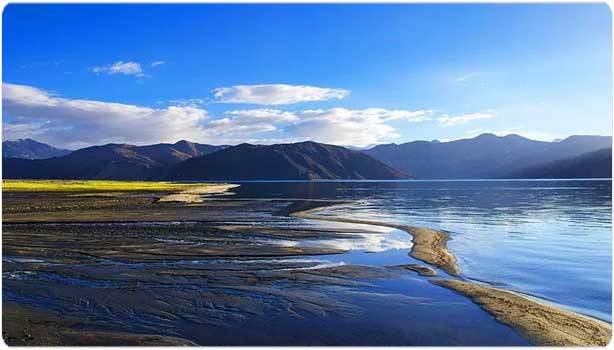These include a variety of gulls, ducks, and geese. There are also a number of interesting animals that has made this region their home. Villages around Pangong reflect the rich Buddhist culture that the people have imbibed over time. This beautiful lake surrounded by picturesque villages is a popular destination for avid trekkers. Also, if you visit the region and want to try your hands (or more like feet) at mountain climbing, there is a mountaineering school that organises classes for climbers.
Best Time To Visit Pangong
The best time to visit is during summers. The weather is warm and pleasant with temperatures ranging between 8 and 21 degree Celsius. Summers in Pangong Tso begin in March and go on until June. The monsoon season, from July to September, brings heavy rainfall to Pangong. The winter season is quite chilly with temperatures ranging from -5 degrees Celsius and 10 degrees Celsius. The winter season, from October to February, is quite popular among winter lovers as the lake is frozen during this time and ice skating is a popular activity.
History Of Pangong
The beautiful lake of Pangong, also called Pangong Tso, which means 'high grassland lake' in Tibetan, is a part of the border with China. Through the lake, passes the 'Line of Actual Control'. The eastern part of the lake, which spans 20 km from the Line of Actual Control, is under China's control. The rest of the lake is a part of India. The Khurnak Fort can be found on the northern bank of the Pangong Tso. The fort, which is now in ruins, has been controlled by the Chinese army since the end of 1958. In 1956, the Chinese government claimed that the border between the two countries left the Khurnak Fort on the Chinese side. In 1960, there were talks regarding the boundary between the Indian and Chinese governments. Records to prove jurisdiction were submitted by the Indian government. One of these records was the Settlement Report on revenue of 1908 that showed the amount of revenue collected at the Khurnak Fort. On October 20, 1962, there were military incursions in the region as a result of the Sino-Indian war.
Relevance to the Indian Army
There are five army check posts on the road to Pangong Tso. At Darbuk village, near Tangste Valley, one can find a few army bunkers and trenches that are highly active. The main attraction here is the chain of war memorials in commemoration of the soldiers who lost their lives during the Indo-Chinese war of 1962. The lake and its surroundings are completely under army surveillance. It was only a few years back that the government decided to open it to tourists.
Flora and Fauna
Animals like yaks and mountain cows can be seen in the sandy area. Besides, the local people/shepherds use the greenlands as grazing grounds for thier domestic animals. The lake is popular for the black necked Siberian crane, bar-headed geese and waterfowl. Several other migratory bird species can also be spotted at the lake.
Tourist Attractions
Chang La Pass
Located at 17,350 feet, this is the third-highest motorable pass in the world. This adventurous place is visited for the picteresque views it provides. Chang La Pass is also a popular destination for trekking.
Monasteries
The lake and the nearby area has a historical significance too. One can find a number of small gompas/monasteries and rock inscriptions, which are believed to be more than 1000 years old.
Mountaineering School
There is an institute that imparts training in various adventure sports like mountaineering, trekking, skiing, rock climbing etc.
How To Access
Thiksey village, famous for its huge monasteries, is the starting point of the Pangong lake. There is nothing beyond this remote village but the extreme mountain ridge for miles. First of all, one needs to travel 30 km down the Manali-leh highway to reach Karu, from where one's papers and documents are verified. The green lush valley of Pangong is about 113 km from Karu.
Natural Beauty
The crystal clear water of the lake produces different colours reflecting the bright sunlight. Bands of blue, green, purple, violet, orange and red colours can be seen on the surface, like a rainbow, making the lake appear like a painted canvas. The area is covered with giant peaks (about 6400 m).


